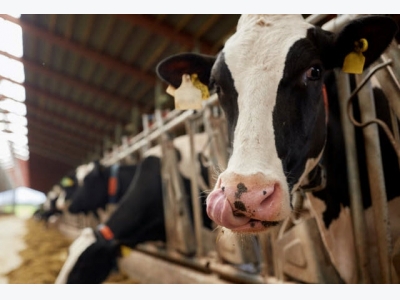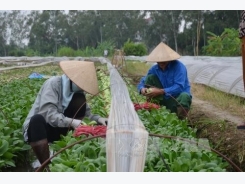What we feed animals is key to a sustainable future for food

Approximately half of global agricultural land is used for feeding animals. Shutterstock
Last week, over a plant-rich lunch underneath the Phoenix sun, a diverse group of GreenBiz attendees gathered to discuss all things protein. On the table was a question that the Protein Challenge group has been wrestling with the past few years: As we approach the 9 billion global population mark in 2040, how will we feed people enough protein in a way that's affordable, healthy and good for the planet?
What's clear about this grand challenge is that we need to tackle both production and consumption.
We know shifting people's diets for health and sustainability will be no small feat, but there is growing interest in protein diversity from consumers, and companies are innovating rapidly to create exciting and appealing new plant-based products. Yet the perception that protein equals meat continues to be a significant barrier, and we know this is often socially and culturally inculcated at a young age. That's one reason why the Protein Challenge 2040 initiative is looking at getting better plant-protein options into school meals, with education being a key piece of the puzzle.
On the other side of the coin, when consumers do eat meat, fish and dairy as part of a diverse diet, we need to make sure they are produced in the most sustainable way possible. Central to this is what we feed our livestock and fish.
Animal feed is a vital yet unseen input to the food industry which has significant implications for environmental health and food security, but yet is rarely talked about. We use precious resources such as land, water and energy to rear animals. Forty-five percent of global greenhouse gas emissions from livestock production are related to feed production and processing. About half of global agricultural land is used for feeding animals, and more than a fifth of wild-caught fish is fed to animals. In many countries, livestock production is accelerating deforestation and biodiversity loss, as well as water scarcity — irrigation of feed crops consumes 12 percent of global groundwater and surface water.
The perception that protein equals meat continues to be a big barrier.
Our new report, "Feed Behind Our Food," is a call for retailers and foodservice to recognize the vital role they have, as trusted intermediaries with consumers, to accelerate progress on sustainable animal feed by collaborating more with their supply chain, from producers and manufacturers to innovators and feed companies.
From a risk management point of view, there is a clear business case for action on animal feed, but changes won't happen overnight. Understanding the vast and complex feed supply chain, the risks that it presents and building a strategy to mitigate these risks will take time.
Thankfully, taking action on animal feed also means capitalizing on significant opportunities. Public attitudes are changing towards food and consumers increasingly demand end-to-end transparency in their food. Working towards more sustainable animal feed presents opportunities to grow consumer trust and brand loyalty, build more resilient supply chains, reduce costs and strengthen supplier relationships.
There is already a lot of progress on this agenda. Many retailers have made strong commitments on traceability, zero deforestation and certified raw materials. The feed industry is rapidly developing tools to assess the sustainability of feed materials.
Exciting new innovations and technologies in sustainable feed solutions might offer opportunities to take the pressure off finite resources. These include sourcing protein from abundant insect sources (which form a natural part of poultry and fish diets), oils from marine algae or methane-digesting bacteria or exploring animal feed additives such as amino acids. While these might not yet be at scale, food businesses could work with suppliers to provide a supportive environment to trial these innovations and help enable the most promising solutions to scale much more quickly.
Moving forward, there is a clear need for additional information to guide effective long-term business decisions in this space. What became clear at my GreenBiz 18 Guru Lunch session was that there's a strong appetite for more information. What are the characteristics of sustainable animal feed? What are the trade-offs in environmental and social impacts if we compare various feed sources and ingredients?
We don't have all the answers, but we're working towards getting them.
To create a protein system fit for the future, the whole supply chain, from retail to feed company, needs to reach a common vision of how to compare feed ingredients.
In the "Feed Behind Our Food" report, we've made the first attempt to articulate a shared set of criteria for what sustainable animal feed looks like. This set of criteria moves away from single issues to address the full spectrum of impacts associated with animal feed, from greenhouse gas emissions and biodiversity to labor rights and financial viability. We also have appointed the Institute of the Environment at the University of Minnesota as an academic partner to help us develop a tool to help the food industry make better-informed decisions about animal feed.
Just as we’re recognizing that humans need a better balance of foods in our diets, we're also starting to recognize that our livestock and fish need more diverse diets that have a lower environmental impact.
There is no "right way forward" to this complex challenge, and gathering the necessary data will be key to creating effective solutions that work in different local contexts. But if we want meat, dairy and fish to be a secure part of the future food system, we can't afford to wait for others, and instead need to take a lead by initiating collaboration with our supply chains to take action on animal feed.
Related news
Tools

Phối trộn thức ăn chăn nuôi

Pha dung dịch thủy canh

Định mức cho tôm ăn

Phối trộn phân bón NPK

Xác định tỷ lệ tôm sống

Chuyển đổi đơn vị phân bón

Xác định công suất sục khí

Chuyển đổi đơn vị tôm

Tính diện tích nhà kính

Tính thể tích ao



 The strawberry whisperer with a BA in economics
The strawberry whisperer with a BA in economics  Engineer develops drones for farmers
Engineer develops drones for farmers